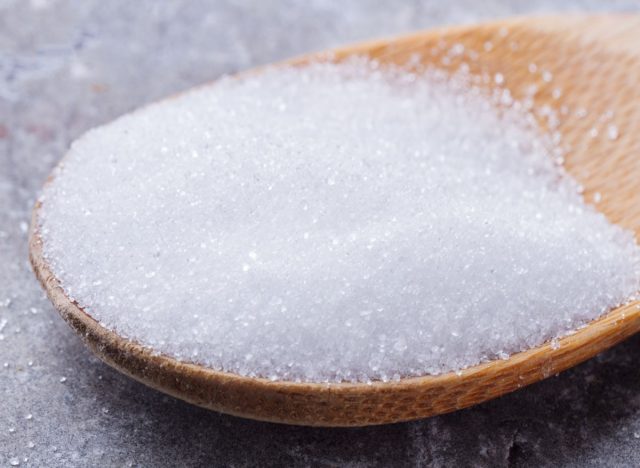A bloated belly can be very uncomfortable– and frankly, annoying. Your belly feels full and tight, and sometimes it may look bigger and stick out. Typically, this is due to gas or digestive distress. There are many ways your stomach can become bloated, such as IBS and even menstruation. Your drinking and eating habits can play a major role in how you bloat as well.
Thankfully, a bloated belly can go away, and there are methods to help reduce the discomfort and get that unwanted pressure out of your body. There are always foods and drinks to consume in order to avoid bloating. According to Molly Hembree, MS, RD, LD, and member of our Medical Expert Board, the worst food for a bloated belly is polyols.
“A type of food to avoid if you have a bloated belly are foods or beverages that contain added sugar alcohols or ‘polyols,'” says Hembree.
According to Hembree, polyols include sugar alcohols such as mannitol, xylitol, maltitol, and sorbitol. Sugar alcohols are lower-calorie sugar alternatives that lead to abdominal gas, bloating, and diarrhea when consumed in excess amounts.
In research posted in the Nutrition Journal, there is a link between polyols and malabsorption–the difficulty in the digestion or absorption of nutrients from food. The research concluded that polyol malabsorption varies from person to person. However, in general, it happens in a dose-dependent fashion, meaning if the dose of the drug is changed, the effects will also change. Malabsorption increases when polyols are consumed in combination with other carbohydrates.
READ RELATED: 15 Signs You’re on the Wrong Side of a Rebound Relationship
The research also suggested that polyols, when consumed in healthy volunteers and patients with IBS, can induce dose-dependent gastrointestinal symptoms of flatulence, bloating, abdominal discomfort, and laxative effects. Although malabsorption is likely the reason for some of the symptoms, there are other factors to take into consideration such as the type of polyol ingested, the consumption pattern, and the colon’s ability to reabsorb water.


When it comes to reducing your polyol intake, you may not know what to look out for. Polyols pop up in a lot of foods, and maybe some that you wouldn’t expect to see.
“These ingredients pop up in everything from sugar-free gum, to lower sugar candies, granola bars, lite fruit spreads, or reduced-calorie ice creams,” says Hembree.
You can also find them in certain fruits and vegetables, such as apples, cauliflower, celery, mushrooms, cherries, and avocado.
“The threshold of sugar alcohol consumption which causes these symptoms is individualized, so it is important to shy as far away from these ingredients as possible if you are actively experiencing bloatedness,” says Hembree.
Kayla Garritano
Source:









